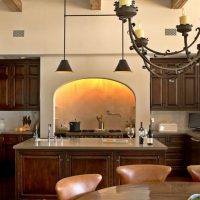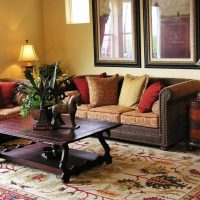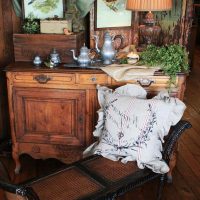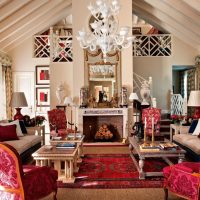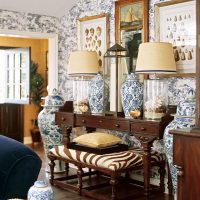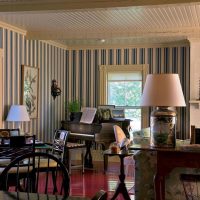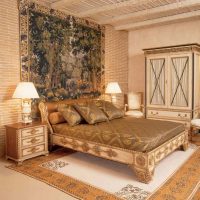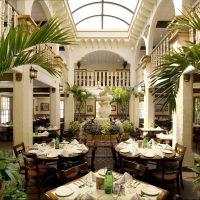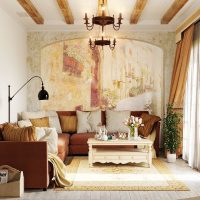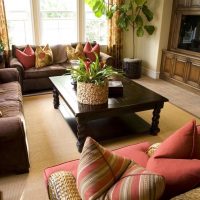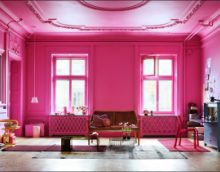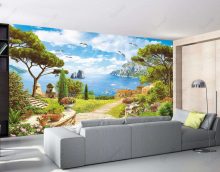The subtleties of interior design in a colonial style
European exoticism - so often called the colonial style. This phrase expresses the whole essence of this unusual design. The era of colonization left a deep mark not only in history and on the political map of the world, but also formed a unique style of housing design, which incorporated the features of European classics and the original flavor of the colonial countries.

Bright and amazing colonial style is still in demand after several centuries.
Content
- 1 How did the colonial style appear in the interior?
- 2 Features and Features
- 3 Secondary Colonial Signs
- 4 Colonial style options in the interior
- 5 Spanish and Indian colonial style in the interior of the kitchen
- 6 Who suits colonial style?
- 7 Colonial style in the interior - design tips
- 8 Video: colonial style apartment design
- 9 50 Colonial Design Examples
How did the colonial style appear in the interior?
Colonial style originated in the era of large-scale land development by Europeans. The colonialists who came to exotic countries for them did not want to live in the not too fashionable and fragile huts of local residents. Therefore, they preferred to settle in the luxurious and comfortable mansions familiar to them. But gradually their houses took on the color of colonized lands.
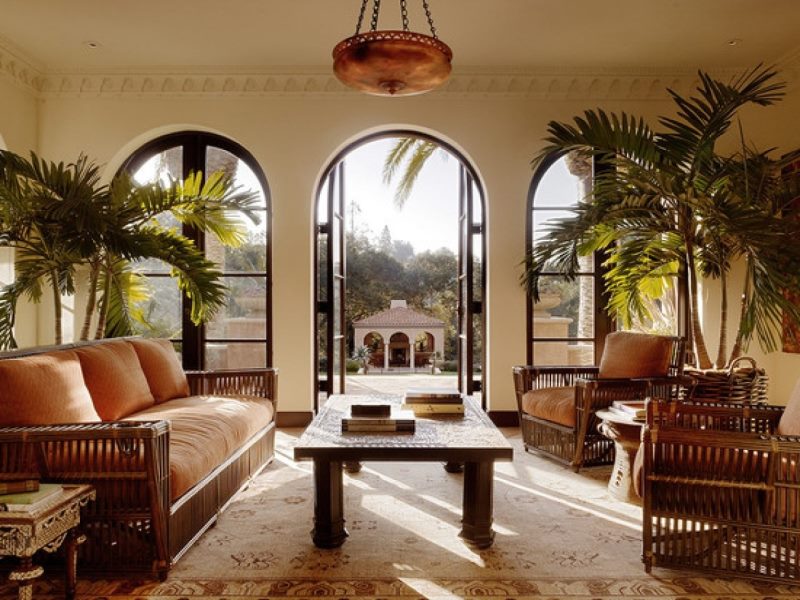
The mixing of styles of colonized countries ultimately led to the emergence of what is now called the colonial style of the interior.
African, Indian, Asian motifs have become part of the colonial style in the home interior of the Spaniards, English, French and Portuguese. So there was an original direction in the design of the premises. At its core, it is a mixture of European classical tradition with the exotic of the East.
Features and Features
This design is considered the most original and in some ways even unique. Firstly, he is one of the most “long-living,” because his story begins in the 15th century. Secondly, it reflected many eras, cultures and traditions. But still he has several common distinguishing features.

Colonial direction harmoniously combines European classics with oriental flavor
A lot of light and space
The owners of the cottages sought to create all conditions in order to fully enjoy the beauty of the untouched nature of exotic countries. Therefore, in the colonial interior, the windows are always large, like the French - they reach the floor and open onto green terraces or the garden. Another characteristic feature is the absence of all kinds of partitions, zoning, and blank doors. The rooms flow smoothly into one another, the clear boundaries of space are blurred. Therefore, houses in the colonial style are always spacious, filled with light, life and natural energy.

The French colonial style gave us the famous panoramic windows
Materials borrowed from nature itself
Only natural materials are suitable for decoration. For internal and external decoration, wood and stone are usually taken. Moreover, along with the usual varieties of wood, exotic varieties are also present: bamboo, rattan, rubber, red and tulip wood. Linen, wool, cotton, silk are selected as textiles. The furniture is made of rattan, natural wood.

Colonial-style wooden ceiling lining
Color spectrum
In most cases, the walls and ceiling are painted in calm and bright colors of the pastel palette.Other soft shades that are as close as possible to the natural ones are perfect for the general background: olive, terracotta, sand, ocher or red clay. This does not mean at all that the presence of bright colors is impossible. They are quite acceptable, but you just need to use them sparingly, skillfully combining them with the rest of the room’s colors.

The walls and ceiling usually appear as a common light background, and expressive dark furniture is selected for contrast
Exotic decor
Of course, such a design would not have been possible without the influence of the East. Ethnomotives are welcome here - shaman masks, figurines, colorful African paths or expensive handmade Indian rugs.
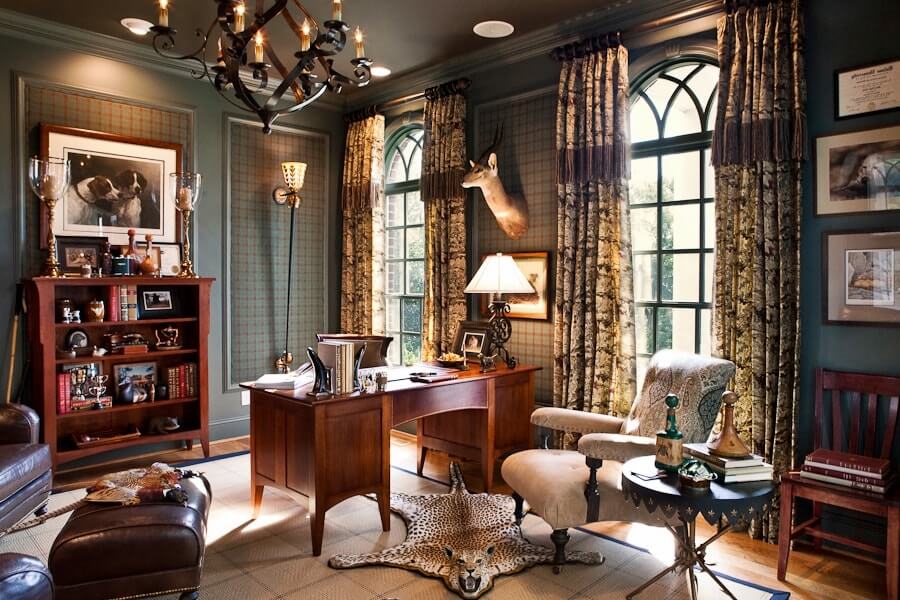
Accessories from the animal world welcome in the interior
Secondary Colonial Signs
There are a number of so-called secondary features of the colonial style that will help to recognize it among the mass of other interior designs:
- Furniture. It must be expensive and natural. At the same time, there are no restrictions in the combination of textures. The living room next door can accommodate a rough table made of solid teak and an elegant rattan chair with thin weaving. And the puff made of leather and the skillfully “aged” cabinet with carvings, reminiscent of the handicraft masterpieces of African or Indian masters, will complement the colorful furniture. In general, vintage elements perfectly reflect eclecticism and authenticity. After all, the only way to convey the spirit of the era of colonization of the eastern lands.

The main criteria for choosing furniture are natural materials, strength and practicality.
- Travel Attributes. The colonialists, in fact, were temporary immigrants. They came to foreign lands, made a career, and after several decades returned home. Therefore, the internal content of rooms often includes all kinds of valise, chests and suitcases. Often they perform a practical role - they serve as a chest of drawers, a bedside table or a pouf. At the same time, such inclusions look very original and successfully complement the colonial style in the interior of the living room, bedroom, kitchen and any other rooms.

The old chest will serve as a coffee table and will be very appropriate as a decor
- Plant elements. The exotic flora that surrounded the houses of Europeans could not but affect the interior of the rooms. Gradually, palm trees, ficus, ferns and creepers migrated to the estates of wealthy settlers from Europe. And still exotic plants are considered a sign inherent in this interior. As a rule, these are large, spreading specimens that are planted in large wooden tubs.

Palm trees add freshness to the colonial-style interior
- "Animal subjects". The design in the African version is often supplemented by the "animal leitmotif." The skins of African leopards, tigers and jaguars are used to decorate the floors. The legs and armrests of chairs, sofas and chairs are carved in the shape of the legs of the same predators. Birdcages, with birds or just decorative ones, are another secondary element that says that the spirit of the era of colonization reigns in the house. Stuffed animals and birds, dried horns and other safari symbols were widely used for decoration in this unusual design.
- Luxurious details. The main indicator of this trend is luxury. She reigns in design, not even trying to be even a little more modest. Everything breathes wealth, abundance and splendor. Gilding on furniture, crystal on chandeliers, trimmings and ivory souvenirs, leather upholstery, mahogany and elegant textiles made of brocade, velvet, wool and natural silk - all this looks more than pretentious.

Antiques are always appropriate - dishes, vases or tapestry
Colonial style options in the interior
Mingling with the colorful decor of India, America, Africa, the classic European interior has acquired new, completely inappropriate features to this. He became original and recognizable.Therefore, this direction of design has several options:
- English. Great Britain is characterized by restraint and orderliness. Therefore, here you will not find chaotically arranged furniture, asymmetry and catchy colors. The central place in the living room is a fireplace with stone trim. Doorways and windows are made in the form of arches. Carpets, crystal chandeliers, floor lamps and lampshades complete the composition.

Colonial-style bedroom
- American. Residents of the United States decided to move away from English moderation and strict aristocracy. The spaciousness, bright space and rich decoration remained. But the symmetry of the design has become secondary. Different rooms in one room could be decorated in different ways.

The American style is less restrained both in decoration and in the arrangement of furniture
- French. Most of this branch was influenced by the culture of Asia, namely, Vietnam and China. Some African states - Morocco, Tunisia and Algeria - have brought their individual flavor. Therefore, in the design of the premises, Asian or African features are often visible. In general, this direction is characterized by lightness, freshness, airiness.

The French direction is characterized by spacious bright rooms
- African. A contrasting combination of English persistence with the expressiveness and dynamism of African latitudes. Respectable British chic diluted with details borrowed from the African savannah - the skins of predators, figures of elephants, giraffes and other representatives of the fauna. Handicrafts are added with a touch of rough, primitive crafts of African tribes. Paints are as close as possible to the nature of Africa.

African bathroom interior
- Spanish. In the exterior, it manifests itself in the form of whole alleys of arches. Inside, arched and curved lines are also found in abundance. The color scheme is light, pastel, with a small amount of bright blotches. Handmade painted tiles are often used in decoration. This tiled decor adorns the internal stairs. On the windows set elegant ornate forged fragments. They are also present on the door handles and in the home decor.

Arches, beams and forged elements are typical features of the Spanish colonial style.
- Indian. A neutral color palette, large and bright panoramic windows, generous filling of the interior with ethnic textiles, decor with bright ornaments and handmade souvenirs - such elements should be present in the interior decoration of the rooms.

Indian colonial style - colorful decorations in the form of textiles and even in the decoration of the ceiling
Spanish and Indian colonial style in the interior of the kitchen
Of all these variations in modern interiors, the Indian and Spanish versions are most often used. They look especially impressive in the design of the kitchen.
To design a kitchen in the Spanish spirit, you must adhere to several rules:
- The walls, floor and ceiling are light, and dark colors are selected for doors, window frames and furniture.
- Doorways follow the shape of an arch.
- For the floor, it is better to choose a tile with Spanish motifs or natural wood.
- Ideally - the presence of a fireplace, wicker furniture and forging.
- Mandatory use of decor with expressive flavor of Spain.
- Use only natural materials. So, for an apron, natural stone will be the best finish.
- It is advisable to choose a kitchen set from expensive wood.
- On the windows are straw shutters.

The main feature of the Spanish direction is the desire to visually increase the area of the kitchen

Doorways are made in the form of arches
Indian Colonial-style cuisine is as follows:
- The walls are painted in warm, natural colors.
- On the ceilings - wooden beams of dark color.
- The floor is made in any of the shades of brown.
- Furniture - simple shapes and configurations.As a rule, it is quite low, with bright upholstery.
- Accessories and textiles in the coloring of India - with rich colors and lush ornaments.
- The chandelier is forged, the windows are panoramic, often decorated in the form of arches, like doorways.

Roughly finished ceiling beams in an Indian colonial style kitchen

Simple wooden table in the kitchen with yellow walls
Who suits colonial style?
Sometimes it is so easy to make a mistake in choosing and give preference to the inappropriate design of the rooms. To prevent such a nuisance, you must immediately decide who the colonial style is all the same suitable for:
- Lovers of travel. If tourist trips are your element, and you constantly bring souvenirs with the color of the countries visited, then in such an interior there will always be a place for them. Even if they are the most “diverse”, after some time they will create a special atmosphere.
- People with an income above the average. Do not forget that European luxury sets the tone for the interior, and the materials used are exclusively natural, sometimes very exotic. All this at times increases the cost of the interior, so do not be surprised if it turns out to be excessively expensive.
- Owners of spacious private homes. To fully realize the idea, large rooms with high ceilings, plenty of windows and free space are needed.
- Fans of eclecticism. Sometimes in one room the attributes of different cultures are mixed, the versatile decor and furniture options. If you are a fan of such “mixes”, then this design is definitely your element.
- To supporters of the classics. When it is difficult to choose a particular home decoration, the solution is simple - stop at the classics (English, French or Spanish) and add details of African, Indian or Moroccan color. Then we get the very colonial style.

Colonial-style home decoration is an expensive pleasure that people above the average income can afford.

Large windows and oriental-style rug
Colonial style in the interior - design tips
In the modern world of design, such a home decor is not so popular. And this lack of demand is easily explained:
- High repair costs due to the use of expensive natural materials.
- Lack of square meters to display all the luxury and grandeur of the design.
- Unusual appearance. Not everyone agrees to such an exotic experiment.

Dark flooring is suitable for flooring, and the variety can be made with carpets and mats
But, if you are seduced by a combination of European luxury and wild, unbridled exoticism, then you will definitely need some useful tips for translating a bold idea:
- Choose a light, pastel base palette for walls and ceilings. Bright colors are not appropriate here. Only small contrasting blotches.
- Add multifunctional furniture to the interior. Colonialists often migrated from meta to place. To convey the spirit of constant mobility, pick up folding furniture, vintage chests to replace the chest of drawers, as well as small tables with crossed legs.
- Make an exotic accent. Wooden figurines, handmade rugs, wicker furniture and other elements of different oriental cultures must be present in the design of the rooms.
- Add design elements of wildlife - a parrot in a cage, a palm tree in a tub. Of course, if the rest of the household is not against such a neighborhood.

Exotic plants must be present in the interior
Video: colonial style apartment design

